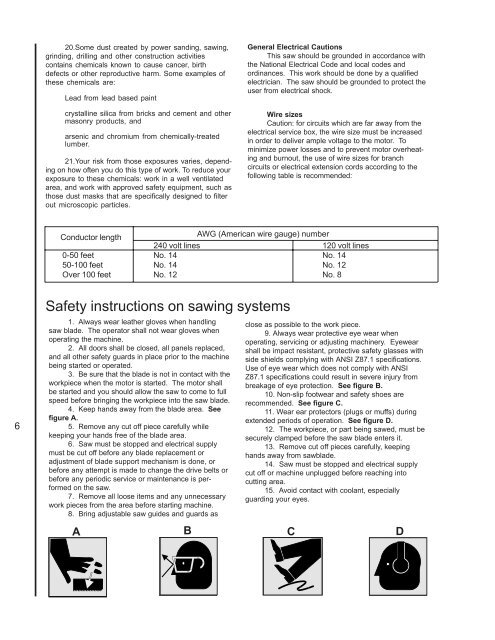7 x 12 Cut-off Band Saw - Igor Chudov
7 x 12 Cut-off Band Saw - Igor Chudov
7 x 12 Cut-off Band Saw - Igor Chudov
You also want an ePaper? Increase the reach of your titles
YUMPU automatically turns print PDFs into web optimized ePapers that Google loves.
6<br />
20.Some dust created by power sanding, sawing,<br />
grinding, drilling and other construction activities<br />
contains chemicals known to cause cancer, birth<br />
defects or other reproductive harm. Some examples of<br />
these chemicals are:<br />
Lead from lead based paint<br />
crystalline silica from bricks and cement and other<br />
masonry products, and<br />
arsenic and chromium from chemically-treated<br />
lumber.<br />
21.Your risk from those exposures varies, depending<br />
on how often you do this type of work. To reduce your<br />
exposure to these chemicals: work in a well ventilated<br />
area, and work with approved safety equipment, such as<br />
those dust masks that are specifically designed to filter<br />
out microscopic particles.<br />
Conductor length<br />
AWG (American wire gauge) number<br />
240 volt lines <strong>12</strong>0 volt lines<br />
0-50 feet No. 14 No. 14<br />
50-100 feet No. 14 No. <strong>12</strong><br />
Over 100 feet No. <strong>12</strong> No. 8<br />
Safety instructions on sawing systems<br />
1. Always wear leather gloves when handling<br />
saw blade. The operator shall not wear gloves when<br />
operating the machine.<br />
2. All doors shall be closed, all panels replaced,<br />
and all other safety guards in place prior to the machine<br />
being started or operated.<br />
3. Be sure that the blade is not in contact with the<br />
workpiece when the motor is started. The motor shall<br />
be started and you should allow the saw to come to full<br />
speed before bringing the workpiece into the saw blade.<br />
4. Keep hands away from the blade area. See<br />
figure A.<br />
5. Remove any cut <strong>off</strong> piece carefully while<br />
keeping your hands free of the blade area.<br />
6. <strong>Saw</strong> must be stopped and electrical supply<br />
must be cut <strong>off</strong> before any blade replacement or<br />
adjustment of blade support mechanism is done, or<br />
before any attempt is made to change the drive belts or<br />
before any periodic service or maintenance is performed<br />
on the saw.<br />
7. Remove all loose items and any unnecessary<br />
work pieces from the area before starting machine.<br />
8. Bring adjustable saw guides and guards as<br />
General Electrical Cautions<br />
This saw should be grounded in accordance with<br />
the National Electrical Code and local codes and<br />
ordinances. This work should be done by a qualified<br />
electrician. The saw should be grounded to protect the<br />
user from electrical shock.<br />
Wire sizes<br />
Caution: for circuits which are far away from the<br />
electrical service box, the wire size must be increased<br />
in order to deliver ample voltage to the motor. To<br />
minimize power losses and to prevent motor overheating<br />
and burnout, the use of wire sizes for branch<br />
circuits or electrical extension cords according to the<br />
following table is recommended:<br />
close as possible to the work piece.<br />
9. Always wear protective eye wear when<br />
operating, servicing or adjusting machinery. Eyewear<br />
shall be impact resistant, protective safety glasses with<br />
side shields complying with ANSI Z87.1 specifications.<br />
Use of eye wear which does not comply with ANSI<br />
Z87.1 specifications could result in severe injury from<br />
breakage of eye protection. See figure B.<br />
10. Non-slip footwear and safety shoes are<br />
recommended. See figure C.<br />
11. Wear ear protectors (plugs or muffs) during<br />
extended periods of operation. See figure D.<br />
<strong>12</strong>. The workpiece, or part being sawed, must be<br />
securely clamped before the saw blade enters it.<br />
13. Remove cut <strong>off</strong> pieces carefully, keeping<br />
hands away from sawblade.<br />
14. <strong>Saw</strong> must be stopped and electrical supply<br />
cut <strong>off</strong> or machine unplugged before reaching into<br />
cutting area.<br />
15. Avoid contact with coolant, especially<br />
guarding your eyes.<br />
A B C D
















